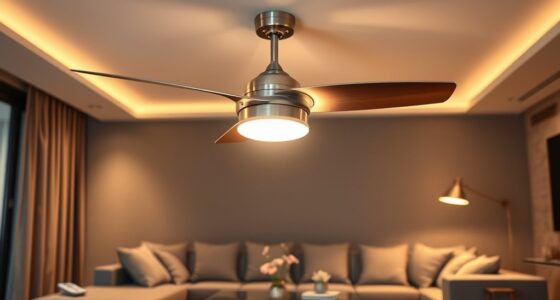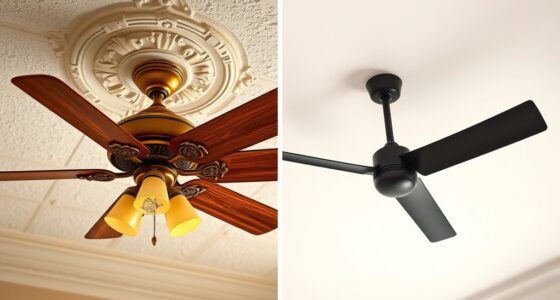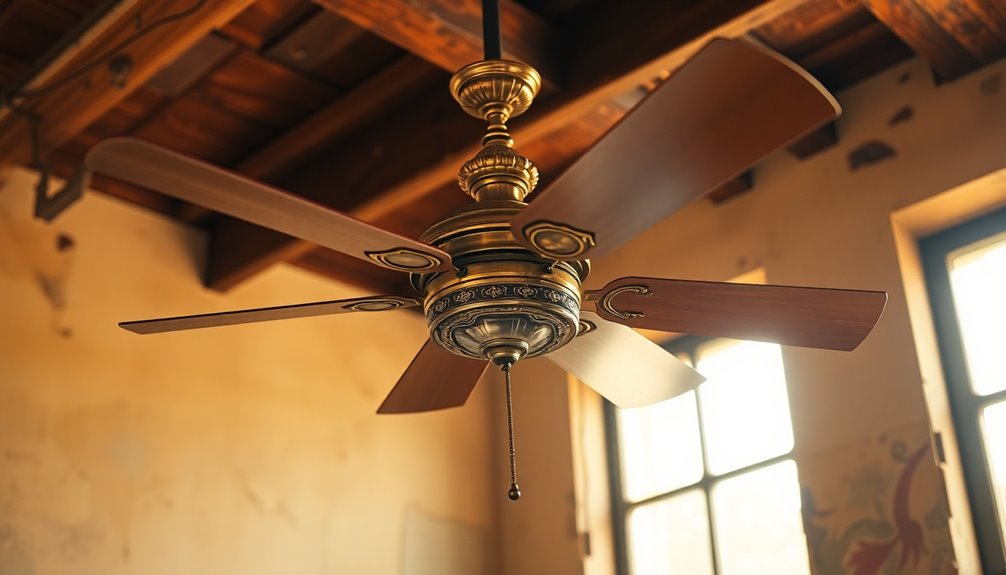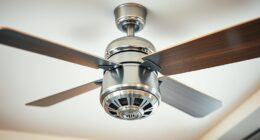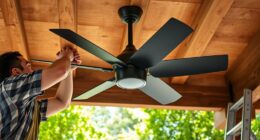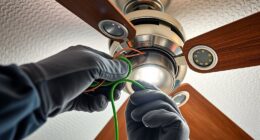The blade pitch on your ceiling fan directly impacts airflow and efficiency. Steeper angles increase the volume and velocity of air moved, providing better cooling but also demanding more energy and exerting mechanical stress. A typical pitch ranges from 12 to 15 degrees, balancing airflow with power consumption. Higher pitches can boost airflow further but may require stronger motors and cause wear. Exploring further reveals how blade design optimizes performance within mechanical limits.
Key Takeaways
- Steeper blade pitch increases the volume and velocity of airflow produced by the ceiling fan.
- Typical blade pitch ranges from 12 to 15 degrees, balancing airflow and energy efficiency.
- Higher pitch blades generate more airflow but require stronger motors and may increase energy consumption.
- Shallow pitches are more energy-efficient and quieter but produce less airflow.
- Proper blade pitch design ensures optimal airflow while minimizing mechanical stress and operating costs.

Have you ever wondered how the angle of your ceiling fan blades impacts airflow and efficiency? Blade pitch, or the tilt of the blades relative to the horizontal plane, directly influences the volume and velocity of air moved by the fan. This angle, typically measured in degrees, determines the aerodynamic profile of each blade, affecting how effectively the fan displaces air within a space. When analyzing blade pitch, it’s essential to understand that a steeper pitch generally results in increased airflow because the blades intercept more air per revolution. Conversely, shallower pitches produce less airflow but tend to operate more efficiently with lower power consumption.
Blade pitch influences airflow volume and efficiency; steeper angles increase air movement but may raise energy use.
The relationship between blade pitch and airflow hinges on the aerodynamic principles of lift and drag. As the pitch increases, the blades resemble airplane wings more closely, generating greater lift force that pushes air downward. This lift translates into higher airflow rates, which is desirable in larger or poorly ventilated spaces. However, increased pitch also elevates the aerodynamic drag on each blade, requiring the motor to exert more torque to maintain rotational speed. This results in higher energy consumption and potential strain on the motor components, especially if the pitch exceeds ideal ranges.
Suitable blade pitch balances airflow with energy efficiency. Most ceiling fans are designed with pitches between 12 and 15 degrees because this range offers a practical compromise: sufficient airflow for comfort while maintaining manageable motor load and energy use. When you adjust your fan’s blades beyond this range, either by design or modification, you risk diminishing returns. For instance, a pitch of 20 degrees or more may produce noticeable airflow increases at the cost of disproportionate energy draw and increased mechanical stress. This can lead to premature wear or motor overheating if not properly rated for such loads.
Furthermore, the effectiveness of a given pitch depends on several factors, including blade shape, size, and the motor’s power capacity. Larger blades with a steeper pitch generate more airflow but require stronger motors and more robust bearings to handle the increased rotational forces. Conversely, fans with shallow pitches are better suited for spaces where energy efficiency and quieter operation are prioritized over maximum airflow. When evaluating or designing ceiling fans, consider that the blade pitch must align with the intended environment, balancing airflow needs against energy consumption and longevity. Proper design and selection of blade pitch ensure optimal performance and durability of your ceiling fan.
Frequently Asked Questions
How Does Blade Pitch Affect Fan Noise Levels?
Blade pitch directly influences fan noise levels; a steeper pitch causes blades to cut through the air more aggressively, increasing turbulence and resulting in louder operation. Conversely, a shallower pitch reduces air resistance, minimizing noise. You should consider adjusting the pitch carefully to balance airflow efficiency with noise reduction. Proper blade alignment and maintenance further guarantee quieter performance, especially at higher speeds where turbulence peaks.
Can Changing Blade Pitch Improve Energy Efficiency?
Adjusting the blade pitch can notably improve your ceiling fan’s energy efficiency. Increasing the pitch enhances airflow, allowing the fan to move more air at lower speeds, reducing energy consumption. Conversely, decreasing pitch may save energy during minimal cooling needs but reduces airflow. By optimizing blade pitch based on your space and usage patterns, you can minimize power usage while maintaining effective airflow, ultimately lowering your energy bills.
What Is the Ideal Blade Pitch for Large Rooms?
You should set your ceiling fan’s blade pitch between 12 and 15 degrees for large rooms. Studies show that at this angle, airflow efficiency increases by up to 20%. This range optimizes air circulation without causing excessive noise or strain on the motor. Precise blade pitch adjustment ensures even air distribution, maintaining comfort and energy efficiency. Proper pitch is essential for maximizing airflow, especially in expansive spaces.
Does Blade Pitch Influence Fan Durability?
Yes, blade pitch influences fan durability. Higher pitches increase the load on motor components, potentially causing faster wear if the fan isn’t rated for such stress. Conversely, a steeper pitch may require a more robust motor and balanced blades to prevent wobbling and mechanical failure. Properly designed blade pitch guarantees ideal airflow without overburdening the motor, thereby extending the fan’s operational lifespan and maintaining structural integrity over time.
How Often Should Blade Pitch Be Adjusted?
You should adjust your ceiling fan blade pitch only when you notice a decrease in airflow or uneven operation, typically every 3-5 years. Environmental factors like dust accumulation or mechanical wear can affect pitch, so inspect blades regularly. Precise adjustments improve efficiency and airflow consistency. Don’t wait for performance issues—regular checks guarantee ideal operation. Keep your blades aligned to maintain peak airflow and energy efficiency over time.
Conclusion
Understanding the pitch of your ceiling fan blades is vital for optimizing airflow efficiency. A steeper pitch increases air movement, but may also heighten motor load and energy consumption. Conversely, a gentler pitch provides quieter operation with reduced airflow. Think of blade pitch as the steering wheel of airflow—adjust it carefully to balance performance and energy use. Mastering this technical detail guarantees your fan operates at peak efficiency, transforming your space into a well-ventilated haven.


